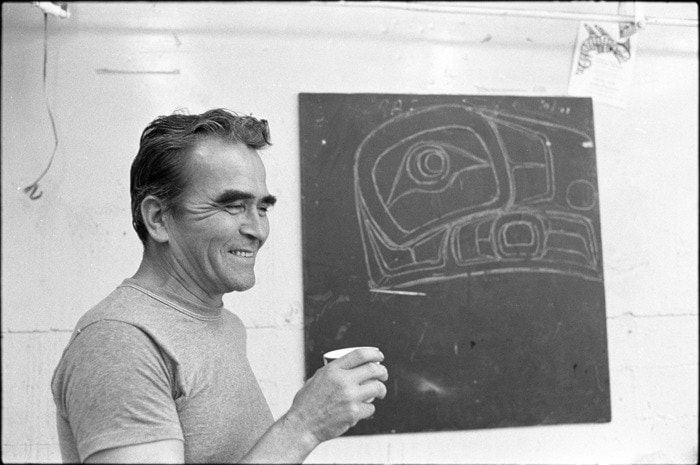Special to the Gazette
He was a talented Alert Bay carver and painter who inspired generations of Native artists, but Doug Cranmer’s considerable contributions are largely unrecognized.
That’s about to change.
The works of Cranmer, who died in 2006 just one year shy of turning 80, is about to be put on display at the University of British Columbia’s Audain Gallery Museum of Anthropology in an exhibit titled: Kesu’: The Art and Life of Doug Cranmer.
Northwest Coast Kwakwaka’wakw art is renowned for its flamboyant, energetic, and colorful carving and painting and Cranmer — an early player in the global commercial art market, and one of the first Native artists in British Columbia to own his own gallery — was among the leading practitioners.
Experts have described his style as understated, elegant, and fresh, and his work quickly found an international following in the 1960s.
The eldest of nine children, Cranmer was born to Daniel and Agnes Cranmer in Alert Bay, BC, but also spent time along the ‘Namgis (Nimpkish) river and in T’salqwadi, the Port Hardy reserve, with his maternal grandmother Abaya Sarah Smith (Hunt) and her husband, Mungo Martin
At 10 months of age, he received his everyday name, Kesu’ — which means “Wealth being carved” — and later, like most men of his generation, he began his working life as a fisherman and, later, a logger.
Cranmer credited Mungo Martin with providing his only artistic educational experiences, although he never formally apprenticed with anyone.
Between 1958 and 1961, Cranmer worked with Bill Reid on the replication of six totem poles, one monumental carving, and two Haida-style houses for the Museum of Anthropology. It was at this time that the Alert Bay native decided to be a full-time carver.
From 1962 to 1967, he had his own gallery, The Talking Stick, in Vancouver and by the early 1960s, he was well established as an independent artist and was producing major sculptural works for both a local and international clientele.
His totem poles — measuring from 20- to 45-ft in height — model house fronts and canoes are in public and private collections in Canada, Spain, Germany, England, New Zealand, Japan and the United States.
In the mid-1970s, Cranmer launched a series of 48 abstract paintings on mahogany plywood that challenged the most daring innovations attempted by his traditional and contemporary mentors.
In the mid 1970s, Cranmer returned home to Alert Bay to teach local Kwakwaka’wakw youth to design and carve so they could participate in the construction of the U’mista Cultural Centre, which opened Nov. 1, 1980.
Doug continued to work with students on such major commissions as replicating and restoring the Wa’kas pole and house front for the Canadian Museum of Civilization’s Grand Hall in 1989, and creating the wooden structures for the Folklife pavilion at Expo ’86 in Vancouver.
In 1986 and 1993, he was hired as artistic designer for the set and props of the theatrical performances “Spirit Lodge” at Expo ’86, and “Mystery Lodge” at Knotts Berry Farm theme park in California. In 1999, Cranmer oversaw the reconstruction of the Alert Bay Big House and selected the appropriate logs for the massive beams to carve replica house posts, and design the house front.
Institutions that hold his artwork include the Canadian Museum of Civilization, Royal Ontario Museum, Glenbow Museum, McMichael Canadian Art Collection, Chicago Field Museum, Royal British Columbia Museum and the UBC Museum of Anthropology.
The exhibit — that captures the artist’s personality, his paradoxes, his range of work, and his profound influence on generations of Northwest Coast artists — opens March 16 and runs until mid-September.
